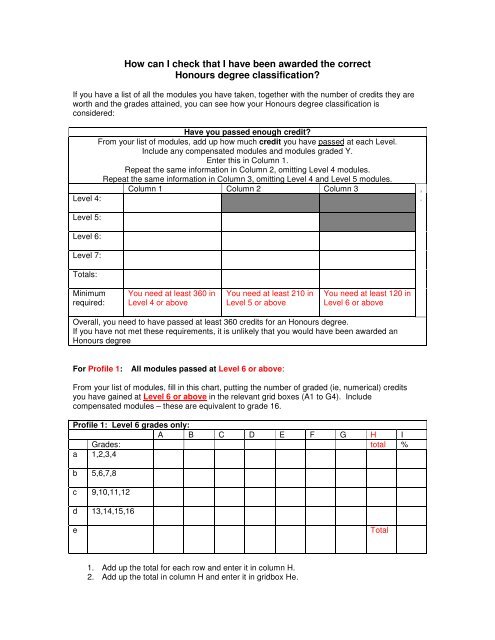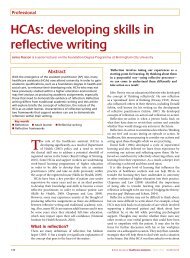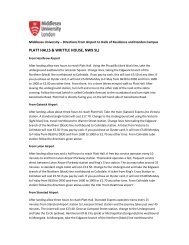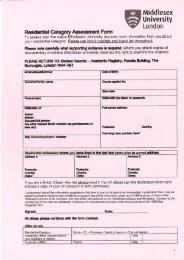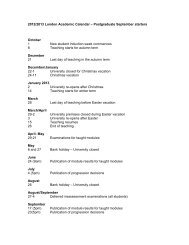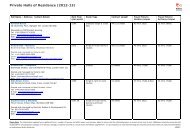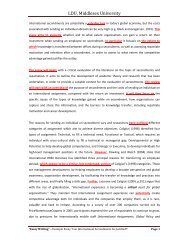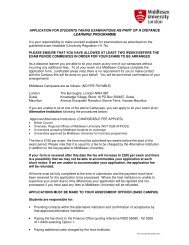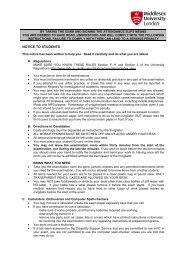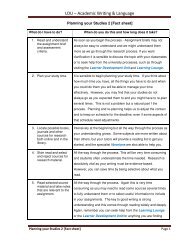Honours - UniHub
Honours - UniHub
Honours - UniHub
Create successful ePaper yourself
Turn your PDF publications into a flip-book with our unique Google optimized e-Paper software.
How can I check that I have been awarded the correct<br />
<strong>Honours</strong> degree classification?<br />
If you have a list of all the modules you have taken, together with the number of credits they are<br />
worth and the grades attained, you can see how your <strong>Honours</strong> degree classification is<br />
considered:<br />
Have you passed enough credit?<br />
From your list of modules, add up how much credit you have passed at each Level.<br />
Include any compensated modules and modules graded Y.<br />
Enter this in Column 1.<br />
Repeat the same information in Column 2, omitting Level 4 modules.<br />
Repeat the same information in Column 3, omitting Level 4 and Level 5 modules.<br />
Column 1 Column 2 Column 3 ,<br />
Level 4:<br />
.<br />
Level 5:<br />
Level 6:<br />
Level 7:<br />
Totals:<br />
Minimum<br />
required:<br />
You need at least 360 in<br />
Level 4 or above<br />
You need at least 210 in<br />
Level 5 or above<br />
You need at least 120 in<br />
Level 6 or above<br />
Overall, you need to have passed at least 360 credits for an <strong>Honours</strong> degree.<br />
If you have not met these requirements, it is unlikely that you would have been awarded an<br />
<strong>Honours</strong> degree<br />
For Profile 1: All modules passed at Level 6 or above:<br />
From your list of modules, fill in this chart, putting the number of graded (ie, numerical) credits<br />
you have gained at Level 6 or above in the relevant grid boxes (A1 to G4). Include<br />
compensated modules – these are equivalent to grade 16.<br />
Profile 1: Level 6 grades only:<br />
A B C D E F G H I<br />
Grades: total %<br />
a 1,2,3,4<br />
b 5,6,7,8<br />
c 9,10,11,12<br />
d 13,14,15,16<br />
e Total<br />
1. Add up the total for each row and enter it in column H.<br />
2. Add up the total in column H and enter it in gridbox He.
3. Work out the credit as a percentage:<br />
a. Divide the total in Ha by the total in He.<br />
b. Multiply this by 100. This is the percentage. Enter it in Ia.<br />
• Eg, if you have a total of 60 credits in grades 1,2,3,4 and a total of 220<br />
credits passed at Level 6, divide 60 by 220 (= 0.27), multiply by 100 (=<br />
27), enter 27% in the gridbox Ia<br />
4. Do the same for each row.<br />
5. If you have worked out the percentages correctly, column I should add up to within 2<br />
decimal points of 100%.<br />
For Profile 2: All modules passed at Level 5 and 6 or above:<br />
6. First enter the totals from column H of Profile 1 into column J of Profile 2.<br />
7. Fill in the chart, putting the number of credits you have gained at Level 5 and 6 in the<br />
relevant grid boxes (Kf to Pi):<br />
Profile 2: Level 5, 6 and 7 grades only:<br />
J K L M N O P Q R<br />
Grades: Level<br />
6 & 7<br />
total<br />
total %<br />
f 1,2,3,4<br />
g 5,6,7,8<br />
h 9,10,11,12<br />
i 13,14,15,16<br />
j Total<br />
8. Add up the total for each row, including the Level 6 & 7 modules in column J, and enter in<br />
column Q.<br />
9. Add up the total in column Q and enter it in gridbox Qj.<br />
10. Work out the credit as a percentage:<br />
a. Divide the total in Qf by the total in Qj.<br />
b. Multiply this by 100. This is the percentage. Enter it in Rf.<br />
11. Do the same for each row.<br />
12. If you have worked out the percentages correctly, column R should add up to within 2<br />
decimal points of 100%.<br />
Definitions:<br />
First class (1 st ) 50% at grades 1 to 4<br />
and less than<br />
25% at grades 13 to 16<br />
Upper Second Class (2.1) 50% at grades 1 to 8<br />
and less than<br />
25% at grades 13 to 16<br />
Lower Second Class (2.2) 50% at grades 1 to 12<br />
A clear profile A borderline profile<br />
50% at grades 1 to 4<br />
and more than<br />
25% at grades 13 to 16<br />
50% at grades 1 to 8<br />
and more than<br />
25% at grades 13 to 16
Third Class (3 rd ) 100% at grades 1 to 16<br />
Is your Profile 1<br />
a Clear Profile or a Borderline Profile?<br />
Enter the Classification from the definition<br />
above:<br />
Is your Profile 2<br />
a Clear Profile or a Borderline Profile?<br />
Enter the Classification from the definition<br />
above:<br />
A clear profile A borderline profile<br />
What classification could I be awarded?<br />
Profile 1: Profile 2: Classification: Regulation:<br />
Clear 1 st Clear 1 st 1 st E4.4.2 i<br />
Clear 1 st Borderline 1 st 1 st E4.4.2 ii<br />
Clear 1 st Clear 2.1 1 st<br />
Clear 1 st Borderline 2.1 1 st or 2.1 or 2.2 Academic Judgement<br />
Clear 1 st Clear 2.2 1 st or 2.1 or 2.2 Academic Judgement<br />
Clear 1 st Clear 3 rd 1 st or 2.1 or 2.2 or 3 rd Academic Judgement<br />
Borderline 1 st Clear 1 st 1 st<br />
Borderline 1 st Borderline 1 st 1 st or 2.1 Academic Judgement<br />
Borderline 1 st Clear 2.1 1 st or 2.1 Academic Judgement<br />
Borderline 1 st Borderline 2.1 1 st or 2.1 or 2.2 Academic Judgement<br />
Borderline 1 st Clear 2.2 1 st or 2.1 or 2.2 Academic Judgement<br />
Borderline 1 st Clear 3 rd 1 st or 2.1 or 2.2 or 3 rd Academic Judgement<br />
Clear 2.1 Clear 1 st 1 st or 2.1 Academic Judgement<br />
E4.4.2 ii<br />
E4.4.3<br />
E4.4.3<br />
E4.4.3<br />
E4.4.2 iii<br />
E4.4.3<br />
E4.4.3<br />
E4.4.3<br />
E4.4.3<br />
E4.4.3<br />
E4.4.3<br />
Clear 2.1 Borderline 1 st 1 st or 2.1 Academic Judgement E4.4.3
Clear 2.1 Clear 2.1 2.1<br />
Clear 2.1 Borderline 2.1 2.1<br />
Clear 2.1 Clear 2.2 2.1<br />
Clear 2.1 Clear 3 rd 2.1 or 2.2 or 3 rd Academic Judgement<br />
Borderline 2.1 Clear 1 st 1 st or 2.1 Academic Judgement<br />
Borderline 2.1 Borderline 1 st 1 st or 2.1 or 2.2 Academic Judgement<br />
Borderline 2.1 Clear 2.1 2.1<br />
Borderline 2.1 Borderline 2.1 2.1 or 2.2 Academic Judgement<br />
Borderline 2.1 Clear 2.2 2.1 or 2.2 Academic Judgement<br />
Borderline 2.1 Clear 3 rd 2.1 or 2.2 or 3 rd Academic Judgement<br />
Clear 2.2 Clear 1 st 1 st or 2.1 or 2.2 Academic Judgement<br />
Clear 2.2 Borderline 1 st 1 st or 2.1 or 2.2 Academic Judgement<br />
Clear 2.2 Clear 2.1 2.1 or 2.2 Academic Judgement<br />
Clear 2.2 Borderline 2.1 2.1 or 2.2 Academic Judgement<br />
Clear 2.2 Clear 2.2 2.2<br />
Clear 2.2 Clear 3 rd 2.2<br />
Clear 3 rd Clear 1 st 1 st or 2.1 or 2.2 or 3 rd Academic Judgement<br />
Clear 3 rd Borderline 1 st 1 st or 2.1 or 2.2 or 3 rd Academic Judgement<br />
Clear 3 rd Clear 2.1 2.1 or 2.2 or 3 rd Academic Judgement<br />
Clear 3 rd Borderline 2.1 2.1 or 2.2 or 3 rd Academic Judgement<br />
Clear 3 rd Clear 2.2 2.2 or 3 rd Academic Judgement<br />
Clear 3 rd Clear 3 rd 3 rd<br />
E4.4.2 i<br />
E4.4.2 ii<br />
E4.4.2 ii<br />
E4.4.3<br />
E4.4.3<br />
E4.4.3<br />
E4.4.2 iii<br />
E4.4.3<br />
E4.4.3<br />
E4.4.3<br />
E4.4.3<br />
E4.4.3<br />
E4.4.3<br />
E4.4.3<br />
E4.4.2 i<br />
E4.4.2 ii<br />
E4.4.3<br />
E4.4.3<br />
E4.4.3<br />
E4.4.3<br />
E4.4.3<br />
E4.4.2 i<br />
What is ‘Academic Judgement’?<br />
The Assessment Board has used its academic judgement to decide which classification to<br />
award you. This is based on the following considerations:<br />
• Level 6 work or work completed in the final stage of the programme;<br />
• The grade achieved for the final dissertation/project module/s;
• Relevant extenuating circumstances submitted to the Assessment Board before the deadline;<br />
• The need to be consistent in its policy in the interpretation of classification for all students in<br />
the cohort.


